Spatio-Temporal Evolution of Land Use Transition and Its Eco-Environmental Effects: A Case Study of the Yellow River Basin, China
Abstract
1. Introduction
2. Materials and Methods
2.1. Study Area
2.2. Data Sources and Processing
2.3. Geo-Information Tupu Methods
2.3.1. Build the Process Tupu of LUT and ESV
2.3.2. Statistics of the Tupu Characteristic
2.4. Calculation of ESV
2.4.1. Revision of Value Coefficient
2.4.2. Spatial Analysis of ESV
3. Results
3.1. Land Use Change in the YRB from 1990 to 2018
3.2. Tupu Analysis of LUTs in the YRB from 1990 to 2018
3.2.1. Spatial Distribution of Tupu Units from 1990 to 2018
3.2.2. Quantity Change of Tupu Units from 1990 to 2018
3.3. The Impact of LUTs on ESV
3.3.1. Changes in ESV from 1990 to 2018
3.3.2. Spatial Distribution of ESV from 1990 to 2018
3.3.3. Changes in ESV in Response to LUT
4. Discussion
4.1. Interpretation of LUTs
4.2. Changes in ESV of Response to LUTs
4.3. Policy Implications
- (1)
- Sustainable land management (SLM) claims to minimize the negative impacts of land degradation [67], which otherwise results in the deprivation of human welfare [68]. However, our research found that the unsustainable use of natural resources was still widespread in the YRB. Owing to the YRB existing across several of China’s administrative provinces, it is urgent to break down the administrative districts and to establish strategic and participatory land use planning, including environmental and social impact assessments. In fact, such schemes of SLM are very tough to implement because of the multiple institutional interests from different sectors at different scales. Therefore, it is necessary for China’s Central Government to establish a unified SLM organization for the YRB for the whole basin. One of the main functions of this organization is to perfect land use planning on the scale of the YRB, so as to make the LUT more scientific and reasonable. Moreover, the medium- and long-term governance blueprint of the YRB can be planned with reference to the advanced experience of the Rhine River or other watershed areas [67], which could ensure the sustainability, integrity, and clarity of the governance path.
- (2)
- In the process of the land use transformation and its management in the YRB, there was an obvious absence in the power of enterprise organizations, social institutions, and the public. On the one hand, these non-governmental organizations have not been well developed, and their strength was still very weak; on the other hand, these social forces lack effective channels to participate. Therefore, the social cooperative governance mechanism is urgent to speed up the establishment and improvement, and let social forces fully participate in the management of the YRB. Additionally, it is necessary to form a situation of social cooperation and co-governance by: (a) clarifying the boundary of responsibility among various social subjects, (b) building an efficient coordination and cooperation mechanism, and (c) establishing a multi-subject governance pattern in the YRB.
- (3)
- The annual per capita ESV of the YRB is only 628 USD and per capita GDP and ESV in 2018 is 12:1, reflecting that the YRB provided very low ESV per capita. Therefore, it is suggested to introduce measurement evaluation of ESV, and integrate the ecosystem services into the decision-making of land use and ecological protection. As we all know, land use for economic growth is unsustainable, so we must make the environmental value decision of land use. However, China’s current land use planning and land use policies do not fully reflect the concept of sustainable land use. A large number of studies have focused on ecosystem services [3,34,55,69,70,71]; how to integrate ecosystem services into land use and ecological protection decisions has always been the focus of discussion [42,72]. Therefore, taking ESV as a quantitative indicator to measure the ecological effect of land use-related policies is of great significance to promote land use decision-making, urban management, and ecosystem protection.
- (4)
- The upper, middle, and lower reaches are the ecological center, energy center, and economic center in China, respectively. Therefore, it is necessary to fully consider the differences of the eco-environment in the upper, middle, and lower reaches, and classify the watershed according to the different protection priorities of the region. The main contradiction of its governance lies in how to balance the relationship between development and protection [66]. Thus, we suggest: (a) exploring the ecological compensation mechanism for carrying out land utilization in the YRB; (b) balancing the economic benefit of different areas and the principal part of land utilization in the upstream, midstream, and downstream of the YRB; and (c) coordinating the interesting relationship between economic construction and ecological protection. Internationally, Payment for Watershed Ecosystem Services (PWES) replaces the concept of Watershed Ecosystem Services [36]. Thus, to eliminate the negative impact of land use on the environment, some suggestions was purposed as follows: (a) taking ESV as the foundation for determining the ecological compensation standard; (b) exploring the establishment of an ecological compensation mechanism for different regions and different principal parts of land utilization in the upstream, midstream, and downstream; and (c) weighing the benefit difference brought by different land use types.
- (5)
- Due to the influence of ecosystem services preference in different land use management types, one or several types of specific ecosystem services were pursued, which could intentionally or unintentionally affect the provision of other ecosystem services [5]. This pattern has led to trade-offs and synergies in ecosystem services [61,73]. Therefore, carrying out in-depth research for the influence that the LUT exerts on ESV can provide decision references for further optimizing land use policies. In order to ensure the coordinated development of ecological, economic, and social benefits in the process of rapid urbanization, measures such as delineating the “three zones and three lines” (three zones—ecological zone, agricultural zone, and urban zone; three lines—permanent basic farmland red line, urban development boundary, and ecological red line) should be promoted [74]. At the same time, it is necessary to strengthen ecological protection and restoration, do more to repair ecological damage, and strive to achieve a good balance between the natural ecosystem and human activities.
4.4. Uncertainties and Challenges for Future Research
5. Conclusions
Author Contributions
Funding
Acknowledgments
Conflicts of Interest
Appendix A
| Transition | In | ||||||
|---|---|---|---|---|---|---|---|
| Cultivated Land | Forestland | Grassland | Water Area | Construction Land | Unused Land | ||
| Out | Cultivated land | / | 12 | 13 | 14 | 15 | 16 |
| Forestland | 21 | / | 23 | 24 | 25 | 26 | |
| Grassland | 31 | 32 | / | 34 | 35 | 36 | |
| Water area | 41 | 42 | 43 | / | 45 | 46 | |
| Construction land | 51 | 52 | 53 | 54 | / | 56 | |
| Unused land | 61 | 62 | 63 | 64 | 65 | / | |
References
- Schmidt, P.; Morrison, T.H. Watershed management in an urban setting: Process, scale and administration. Land Use Policy 2012, 29, 45–52. [Google Scholar] [CrossRef]
- Liu, Y.; Bi, J.; Lv, J. Classification of ecosystem services and a reclassification framework of watershed ecosystem services. Resour. Sci. 2019, 41, 1189–1200. [Google Scholar] [CrossRef]
- Long, H.; Liu, Y.; Hou, X.; Li, T.; Li, Y. Effects of land use transitions due to rapid urbanization on ecosystem services: Implications for urban planning in the new developing area of China. Habitat Int. 2014, 44, 536–544. [Google Scholar] [CrossRef]
- Lu, X.; Shi, Y.; Chen, C.; Yu, M. Monitoring cropland transition and its impact on ecosystem services value in developed regions of China: A case study of Jiangsu Province. Land Use Policy 2017, 69, 25–40. [Google Scholar] [CrossRef]
- Chen, W.; Zhao, H.; Li, J.; Zhu, L.; Wang, Z.; Zeng, J. Land use transitions and the associated impacts on ecosystem services in the Middle Reaches of the Yangtze River Economic Belt in China based on the geo-informatic Tupu method. Sci. Total Environ. 2020, 701, 134690. [Google Scholar] [CrossRef] [PubMed]
- Wang, S.; Liu, J.; Ma, T. Dynamics and changes in spatial patterns of land use in Yellow River Basin, China. Land Use Policy 2010, 27, 313–323. [Google Scholar] [CrossRef]
- Fang, C. Spatial Organization Pattern and High-Quality Development of Urban Agglomeration in the Yellow River Basin. Econ. Geogr. 2020, 40, 1–8. [Google Scholar] [CrossRef]
- Lu, D.; Sun, D. Development and management tasks of the Yellow River Basin: A preliminary understanding and suggestion. Acta Geogr. Sin. 2019, 74, 2431–2436. [Google Scholar] [CrossRef]
- Zhang, W.; Wang, L.; Xiang, F.; Qin, W.; Jiang, W. Vegetation dynamics and the relations with climate change at multiple time scales in the Yangtze River and Yellow River Basin, China. Ecol. Indic. 2020, 10, 105892. [Google Scholar] [CrossRef]
- Wohlfart, C.; Mack, B.; Liu, G.; Kuenzer, C. Multi-faceted land cover and land use change analyses in the Yellow River Basin based on dense Landsat time series: Exemplary analysis in mining, agriculture, forest, and urban areas. Appl. Geogr. 2017, 85, 73–88. [Google Scholar] [CrossRef]
- Zhang, B.; Miao, C. Spatiotemporal changes and driving forces of land use in the Yellow River Basin. Resour. Sci. 2020, 42, 460–473. [Google Scholar] [CrossRef]
- Xu, S.; Yu, Z.; Yang, C.; Ji, X.; Zhang, K. Trends in evapotranspiration and their responses to climate change and vegetation greening over the upper reaches of the Yellow River Basin. Agric. For. Meteorol. 2018, 263, 118–129. [Google Scholar] [CrossRef]
- Daily, G.C.; Soderqvist, T.; Aniyar, S.; Arrow, K.; Dasgupta, P.; Paul, R. The Value of Nature and the Nature of Value. Science 2000. [Google Scholar] [CrossRef] [PubMed]
- Perring, M.P.; De Frenne, P.; Baeten, L.; Maes, S.L.; Depauw, L.; Blondeel, H.; Caron, M.M.; Verheyen, K. Global environmental change effects on ecosystems: The importance of land-use legacies. Glob. Chang. Biol. 2016, 22, 1361–1371. [Google Scholar] [CrossRef]
- Lambin, E.F.; Meyfroidt, P. Land use transitions: Socio-ecological feedback versus socio-economic change. Land Use Policy 2010, 27, 108–118. [Google Scholar] [CrossRef]
- Long, H.; Li, T. The coupling characteristics and mechanism of farmland and rural housing land transition in China. J. Geogr. Sci. 2012, 22, 548–562. [Google Scholar] [CrossRef]
- Tsai, Y.; Zia, A.; Koliba, C.; Bucini, G.; Guilbert, J.; Beckage, B. An interactive land use transition agent-based model (ILUTABM): Endogenizing human-environment interactions in the Western Missisquoi Watershed. Land Use Policy 2015, 49, 161–176. [Google Scholar] [CrossRef]
- Long, H.; Qu, Y. Land use transitions and land management: A mutual feedback perspective. Land Use Policy 2018, 74, 111–120. [Google Scholar] [CrossRef]
- Liu, J.; Kuang, W.; Zhang, Z.; Xu, X.; Qin, Y.; Ning, J.; Zhou, W.; Zhang, S.; Li, R.; Yan, C.; et al. Spatiotemporal characteristics, patterns, and causes of land-use changes in China since the late 1980s. J. Geogr. Sci. 2014, 24, 195–210. [Google Scholar] [CrossRef]
- Ning, J.; Liu, J.; Kuang, W.; Xu, X.; Zhang, S.; Yan, C.; Li, R.; Wu, S.; Hu, Y.; Du, G.; et al. Spatio-temporal patterns and characteristics of land-use change in China during 2010–2015. Acta Geogr. Sin. 2018, 28, 547–561. [Google Scholar] [CrossRef]
- Sun, P.; Xu, Y.; Wang, S. Terrain gradient effect analysis of land use change in poverty area around Beijing and Tianjin. Trans. Chin. Soc. Agric. Eng. 2014, 30, 277–288. [Google Scholar] [CrossRef]
- Wang, C.; Wang, Y.; Wang, R.; Zheng, P. Modeling and evaluating land-use/land-cover change for urban planning and sustainability: A case study of Dongying city, China. J. Clean Prod. 2018, 172, 1529–1534. [Google Scholar] [CrossRef]
- Liu, J.; Wang, P.; Li, J.; Xu, J.; Liu, X. An Algorithm for Land-Use Pattern Index and Its Application. Geogr. Geo-Inf. Sci. 2009, 25, 107–109. [Google Scholar]
- Long, H.; Li, X. Analysis on regional land use transition: A case study in Transect of the Yangtze River. J. Nat. Resour. 2002, 17, 144–149. [Google Scholar]
- Song, X. Discussion on land use transition research framework. Acta Geogr. Sin. 2017, 72, 471–487. [Google Scholar]
- Nizalov, D.; Thornsbury, S.; Loveridge, S.; Woods, M.; Zadorozhna, O. Security of property rights and transition in land use. J. Comp. Econ. 2016, 44, 76–91. [Google Scholar] [CrossRef]
- Liu, Y.; Long, H.; Li, T.; Tu, S. Land use transitions and their effects on water environment in Huang-Huai-Hai Plain, China. Land Use Policy 2015, 47, 293–301. [Google Scholar] [CrossRef]
- Costanza, R.; Arge, R.; Groot, R.D.; Farberk, S.; Belt, M.V.D. The value of the world’s ecosystem services and natural capital. Nature 1997, 387, 253–260. [Google Scholar] [CrossRef]
- Costanza, R.; de Groot, R.; Sutton, P.; van der Ploeg, S.; Anderson, S.J.; Kubiszewski, I.; Farber, S.; Turner, R.K. Changes in the global value of ecosystem services. Glob. Environ. Chang. 2014, 26, 152–158. [Google Scholar] [CrossRef]
- Redford, K.H.; Adams, W.M. Payment for Ecosystem Services and the Challenge of Saving Nature. Conserv. Biol. 2009, 23, 785–787. [Google Scholar] [CrossRef]
- Gascoigne, W.R.; Hoag, D.; Koontz, L.; Tangen, B.A.; Shaffer, T.L.; Gleason, R.A. Valuing ecosystem and economic services across land-use scenarios in the Prairie Pothole Region of the Dakotas, USA. Ecol. Econ. 2011, 70, 1715–1725. [Google Scholar] [CrossRef]
- Rounsevell, M.D.A.; Pedroli, B.; Erb, K.; Gramberger, M.; Busck, A.G.; Haberl, H.; Kristensen, S.; Kuemmerle, T.; Lavorel, S.; Lindner, M.; et al. Challenges for land system science. Land Use Policy 2012, 29, 899–910. [Google Scholar] [CrossRef]
- Foley, J.A. Global Consequences of Land Use. Science 2005, 309, 570–574. [Google Scholar] [CrossRef] [PubMed]
- Tolessa, T.; Senbeta, F.; Kidane, M. The impact of land use/land cover change on ecosystem services in the central highlands of Ethiopia. Ecosyst. Serv. 2017, 23, 47–54. [Google Scholar] [CrossRef]
- Song, W.; Deng, X. Land-use/land-cover change and ecosystem service provision in China. Sci. Total Environ. 2017, 576, 705–719. [Google Scholar] [CrossRef]
- Hauck, J.; Görg, C.; Varjopuro, R.; Ratamäki, O.; Jax, K. Benefits and limitations of the ecosystem services concept in environmental policy and decision making: Some stakeholder perspectives. Environ. Sci. Policy 2013, 25, 13–21. [Google Scholar] [CrossRef]
- De Groot, R.S.; Alkemade, R.; Braat, L.; Hein, L.; Willemen, L. Challenges in integrating the concept of ecosystem services and values in landscape planning, management and decision making. Ecol. Complex 2010, 7, 260–272. [Google Scholar] [CrossRef]
- Xie, G.; Zhen, L.; Lu, C.; Xiao, Y.; Chen, C. Expert Knowledge Based Valuation Method of Ecosystem Services in China. J. Nat. Resour. 2008, 23, 911–919. [Google Scholar]
- Xie, G.; Zhang, C.; Zhang, C.; Xiao, Y.; Lu, C. The value of ecosystem services in China. Resour. Sci. 2015, 37, 1740–1746. [Google Scholar]
- Chaikaew, P.; Hodges, A.W.; Grunwald, S. Estimating the value of ecosystem services in a mixed-use watershed: A choice experiment approach. Ecosyst. Serv. 2017, 23, 228–237. [Google Scholar] [CrossRef]
- De Oliveira, V.A.; de Mello, C.R.; Beskow, S.; Viola, M.R.; Srinivasan, R. Modeling the effects of climate change on hydrology and sediment load in a headwater basin in the Brazilian Cerrado biome. Ecol. Eng. 2019, 133, 20–31. [Google Scholar] [CrossRef]
- Liu, J.; Jin, X.; Xu, W.; Fan, Y.; Ren, J.; Zhang, X.; Zhou, Y. Spatial coupling differentiation and development zoning trade-off of land space utilization efficiency in eastern China. Land Use Policy 2019, 85, 310–327. [Google Scholar] [CrossRef]
- Wang, G.; Wang, S.; Chen, Z. Land-use /land-cover changes in the Yellow River basin. J. Tsinghua Univ. Sci. Technol. 2004, 44, 1218–1222. [Google Scholar]
- Jiang, W.; Yuan, L.; Wang, W.; Cao, R.; Zhang, Y.; Shen, W. Spatio-temporal analysis of vegetation variation in the Yellow River Basin. Ecol. Indic. 2015, 51, 117–126. [Google Scholar] [CrossRef]
- He, Z.; He, J. Remote Sensing on Spatio-temporal Evolution of Vegetation Cover in the Yellow River Basin during 1982—2013. Trans. Chin. Soc. Agric. Mach. 2017, 48, 179–185. [Google Scholar] [CrossRef]
- Omer, A.; Elagib, N.A.; Zhuguo, M.; Saleem, F.; Mohammed, A. Water scarcity in the Yellow River Basin under future climate change and human activities. Sci. Total Environ. 2020, 749, 141446. [Google Scholar] [CrossRef]
- Tang, Y.; Tang, Q.; Tian, F.; Zhang, Z.; Liu, G. Responses of natural runoff to recent climatic variations in the Yellow River basin, China. Hydrol. Earth Syst. Sci. 2013, 17, 4471–4480. [Google Scholar] [CrossRef]
- Liu, J.; Liu, M.; Zhuang, D.; Zhang, Z.; Deng, X. Study on spatial pattern of land-use change in China during 1995—2000. Sci. China Ser. D Earth Sci. 2003, 46, 373–384. [Google Scholar]
- Liu, J.; Zhang, Z.; Xu, X.; Kuang, W.; Zhou, W.; Zhang, S.; Li, R.; Yan, C.; Yu, D.; Wu, S.; et al. Spatial Patterns and Driving Forces of Land Use Change in China in the Early 21st Century. Acta Geogr. Sin. 2009, 64, 1411–1420. [Google Scholar] [CrossRef]
- Liao, K. The Discussion and Prospect for Geo-Informatic Tupu. Geo-Inf. Sci. 2002, 3, 14–20. [Google Scholar]
- Wan, J.; Zhu, G.; Peng, Q. Land Use Information Tupu and Its Application. Geomat. Inf. Sci. Wuhan Univ. 2005, 30, 355–358. [Google Scholar] [CrossRef]
- Chen, S.; Yue, T.; Li, H. Studies on Geo-Informatic Tupu and its application. Geogr. Res. Aust. 2000, 19, 337–343. [Google Scholar]
- Ye, Q.; Liu, G.; Lu, Z.; Gong, Z.; Marco, M. Research of TUPU on Land Use/ Land Cover Change Based on GIS. Prog. Geogr. 2002, 21, 349–357. [Google Scholar] [CrossRef]
- Wang, J.; Shao, J.; Li, Y. Geo-Spectrum Based Analysis of Crop and Forest Land Use Change in the Recent 20 Years in the Three Gorges Reservoir Area. J. Nat. Resour. 2015, 30, 235–247. [Google Scholar] [CrossRef]
- Gong, W.; Yuan, L. Analysis of Land Use and Its Ecosystem Service Value Change by Graphic Information: A Case Study of Harbin Section of Songhuajiang Watershed. Environ. Technol. 2010, 33, 200–205. [Google Scholar] [CrossRef]
- Yang, A.; Zhu, L.; Chen, S.; Jin, H.; Xia, X. Geo-informatic spectrum analysis of land use change in the Manas River Basin, China during 1975–2015. Chin. J. Appl. Ecol. 2019, 30, 3863–3874. [Google Scholar]
- Nahuelhual, L.; Vergara, X.; Kusch, A.; Campos, G.; Droguett, D. Mapping ecosystem services for marine spatial planning: Recreation opportunities in Sub-Antarctic Chile. Mar. Policy 2017, 81, 211–218. [Google Scholar] [CrossRef]
- Wang, Y.; Dai, E.; Yin, L.; Ma, L. Land use/land cover change and the effects on ecosystem services in the Hengduan Mountain region, China. Ecosyst. Serv. 2018, 34, 55–67. [Google Scholar] [CrossRef]
- Wang, B.; Yang, Q.; Liu, Z. Effect of conversion of farmland to forest or grassland on soil erosion intensity changes in Yanhe River Basin, Loess Plateau of China. Front. For. China 2009, 4, 68–74. [Google Scholar] [CrossRef]
- Kong, D.; Miao, C.; Wu, J.; Duan, Q. Impact assessment of climate change and human activities on net runoff in the Yellow River Basin from 1951 to 2012. Ecol. Eng. 2016, 91, 566–573. [Google Scholar] [CrossRef]
- Haase, D.; Schwarz, N.; Strohbach, M.; Kroll, F.; Seppelt, R. Synergies, Trade-offs, and Losses of Ecosystem Services in Urban Regions: An Integrated Multiscale Framework Applied to the Leipzig-Halle Region, Germany. Ecol. Soc. 2012, 17. [Google Scholar] [CrossRef]
- Yu, H.; Bian, Z.; Chen, F. Mechanism of Land Ecological Restoration in Mining Area: An Analy-sis based on Land Degradation Neutrality Framework. China Land Sci. 2020, 34, 86–95. [Google Scholar] [CrossRef]
- Shen, X.; Wang, L.; Wu, C.; Lv, T.; Lu, Z.; Luo, W.; Li, G. Local interests or centralized targets? How China’s local government implements the farmland policy of Requisition–Compensation Balance. Land Use Policy 2017, 67, 716–724. [Google Scholar] [CrossRef]
- Yang, J.; Xie, B.; Zhang, D. Spatio-temporal variation of water yield and its response to precipitation and land use change in the Yellow River Basin based on InVEST model. Chin. J. Appl. Ecol. 2020, 31, 2731–2739. [Google Scholar] [CrossRef]
- Liu, G.; Yang, Q.; Huang, J. The Change Characteristics and Influence Factors of Ecosystem Services Valuation of the Yellow River Basin from 2000 to 2015. Environ. Conform. Assess. 2020, 12, 90–97. [Google Scholar] [CrossRef]
- Yu, H.; Bian, Z.; Mu, S.; Yuan, J.; Chen, F. Effects of Climate Change on Land Cover Change and Vegetation Dynamics in Xinjiang, China. Int. J. Environ. Res. Public Health 2020, 17, 4865. [Google Scholar] [CrossRef] [PubMed]
- Vogl, A.L.; Bryant, B.P.; Hunink, J.E.; Wolny, S.; Apse, C.; Droogers, P. Valuing investments in sustainable land management in the Upper Tana River basin, Kenya. J. Environ. Manag. 2017, 195, 78–91. [Google Scholar] [CrossRef]
- Siegmund-Schultze, M.; Ppel, J.K.; Sobral, M.D.C. Unraveling the water and land nexus through inter- and transdisciplinary research: Sustainable land management in a semi-arid watershed in Brazil’s Northeast. Reg. Environ. Chang. 2018, 15, 2005–2017. [Google Scholar] [CrossRef]
- Song, W.; Deng, X.; Liu, B.; Li, Z.; Jin, G. Impacts of Grain-for-Green and Grain-for-Blue Policies on Valued Ecosystem Services in Shandong Province, China. Adv. Meteorol. 2015, 2015, 1–10. [Google Scholar] [CrossRef]
- Schirpke, U.; Kohler, M.; Leitinger, G.; Fontana, V.; Tasser, E.; Tappeiner, U. Future impacts of changing land-use and climate on ecosystem services of mountain grassland and their resilience. Ecosyst. Serv. 2017, 26, 79–94. [Google Scholar] [CrossRef]
- Cao, Y.; Li, G.; Tian, Y.; Fang, X.; Li, Y.; Tan, Y. Linking ecosystem services trade-offs, bundles and hotspot identification with cropland management in the coastal Hangzhou Bay area of China. Land Use Policy. 2020, 97, 104689. [Google Scholar] [CrossRef]
- Liu, W.; Zhan, J.; Zhao, F.; Yan, H.; Zhang, F.; Wei, X. Impacts of urbanization-induced land-use changes on ecosystem services: A case study of the Pearl River Delta Metropolitan Region, China. Ecol. Indic. 2019, 98, 228–238. [Google Scholar] [CrossRef]
- Bennett, E.M.; Peterson, G.D.; Gordon, L.J. Understanding relationships among multiple ecosystem services. Ecol. Lett. 2009, 12, 1394–1404. [Google Scholar] [CrossRef] [PubMed]
- Lian, X. Review on Advanced Practice of Provincial Spatial Planning: Case of a Western, Less Developed Province. Int. Rev. Spat. Plan. Sustain. Dev. 2018, 6, 185–202. [Google Scholar] [CrossRef]
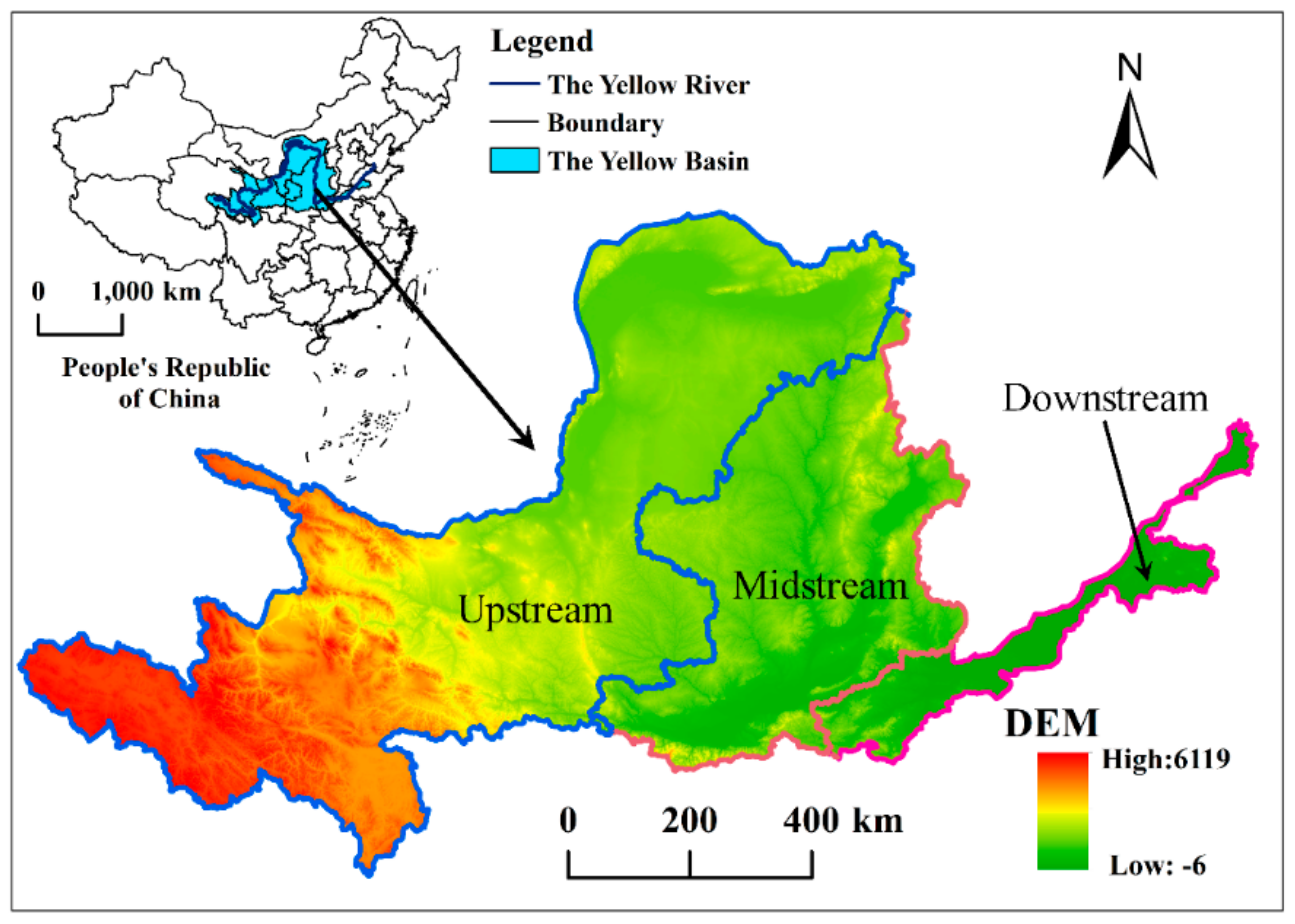
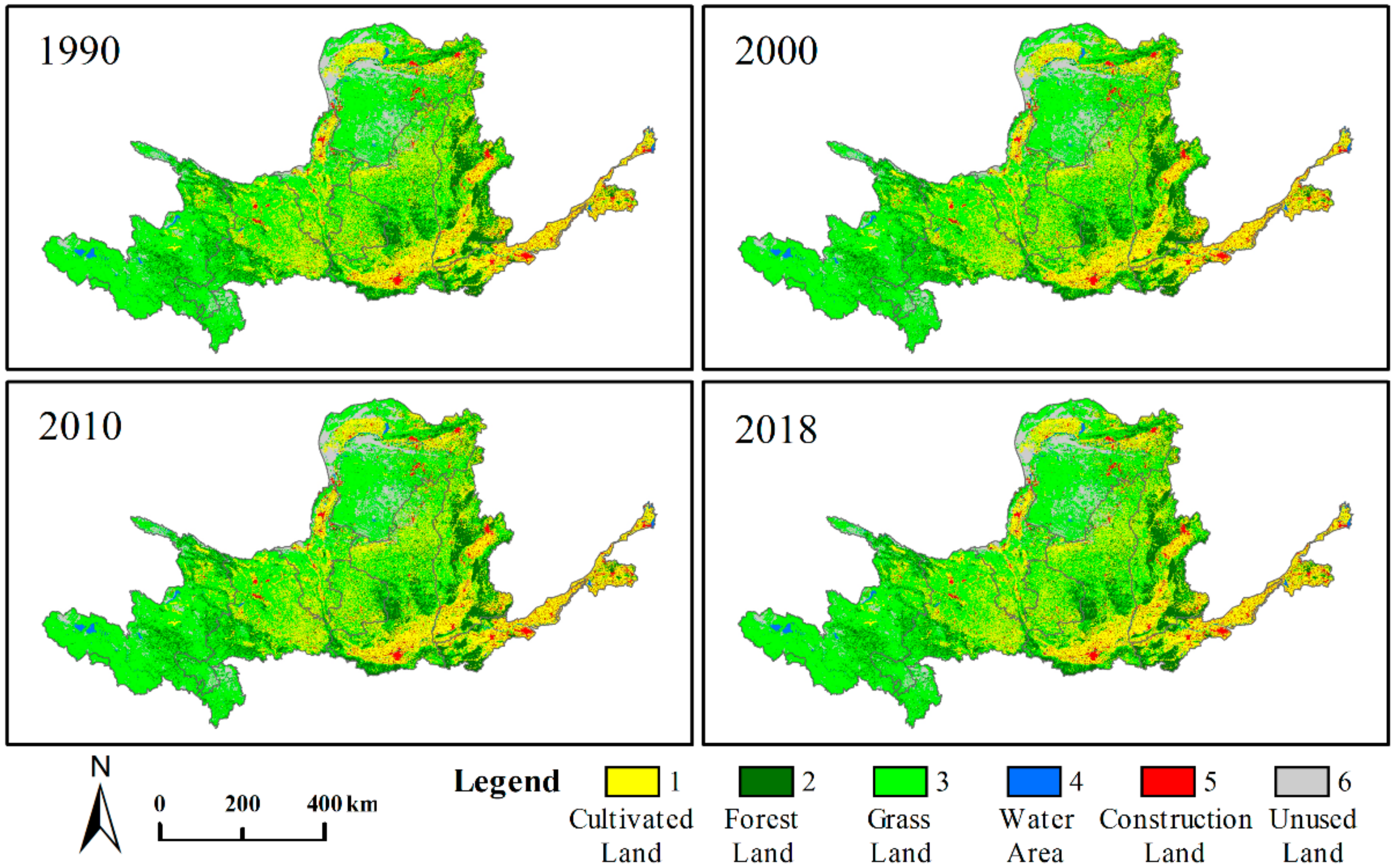
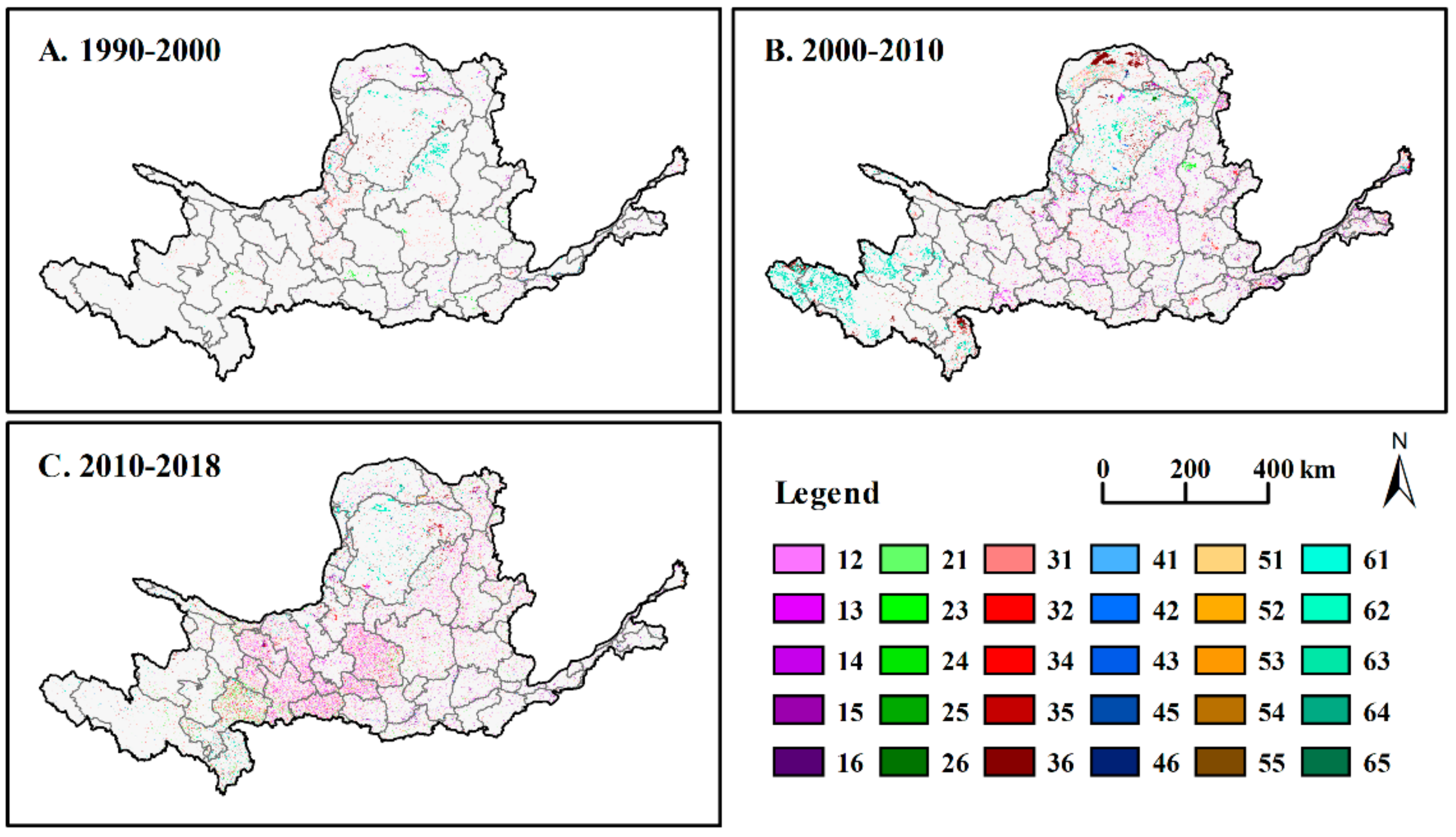
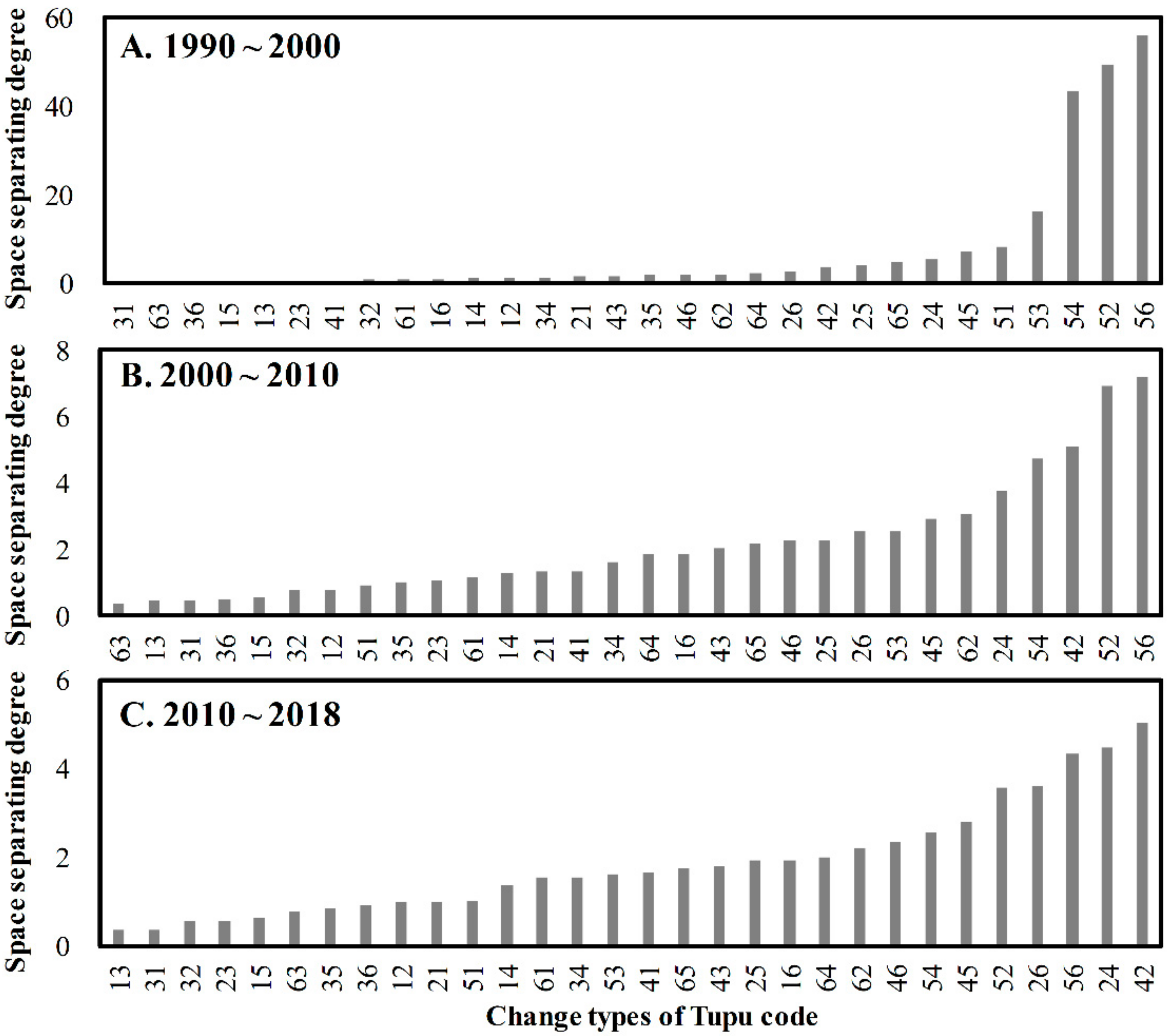
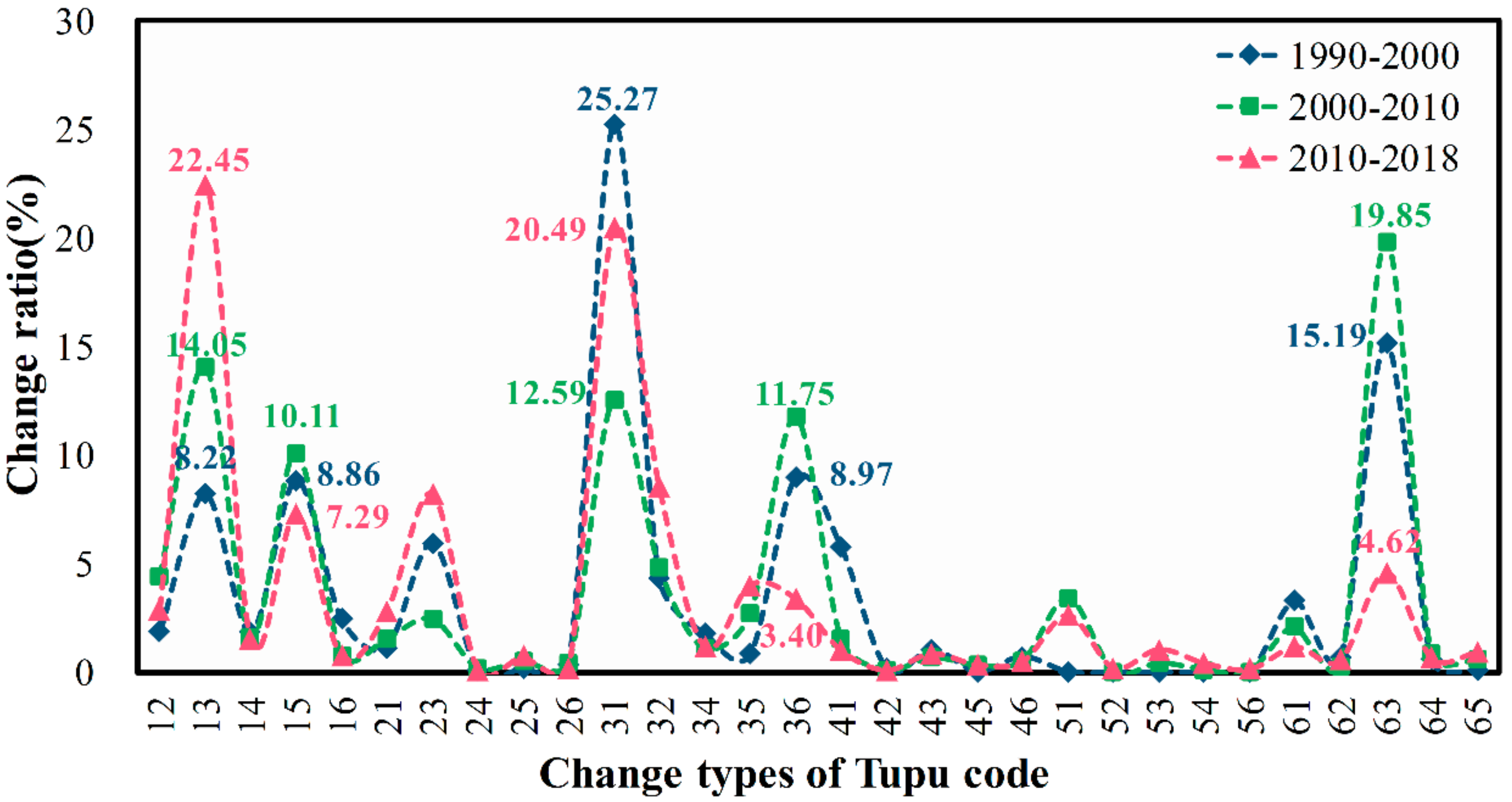
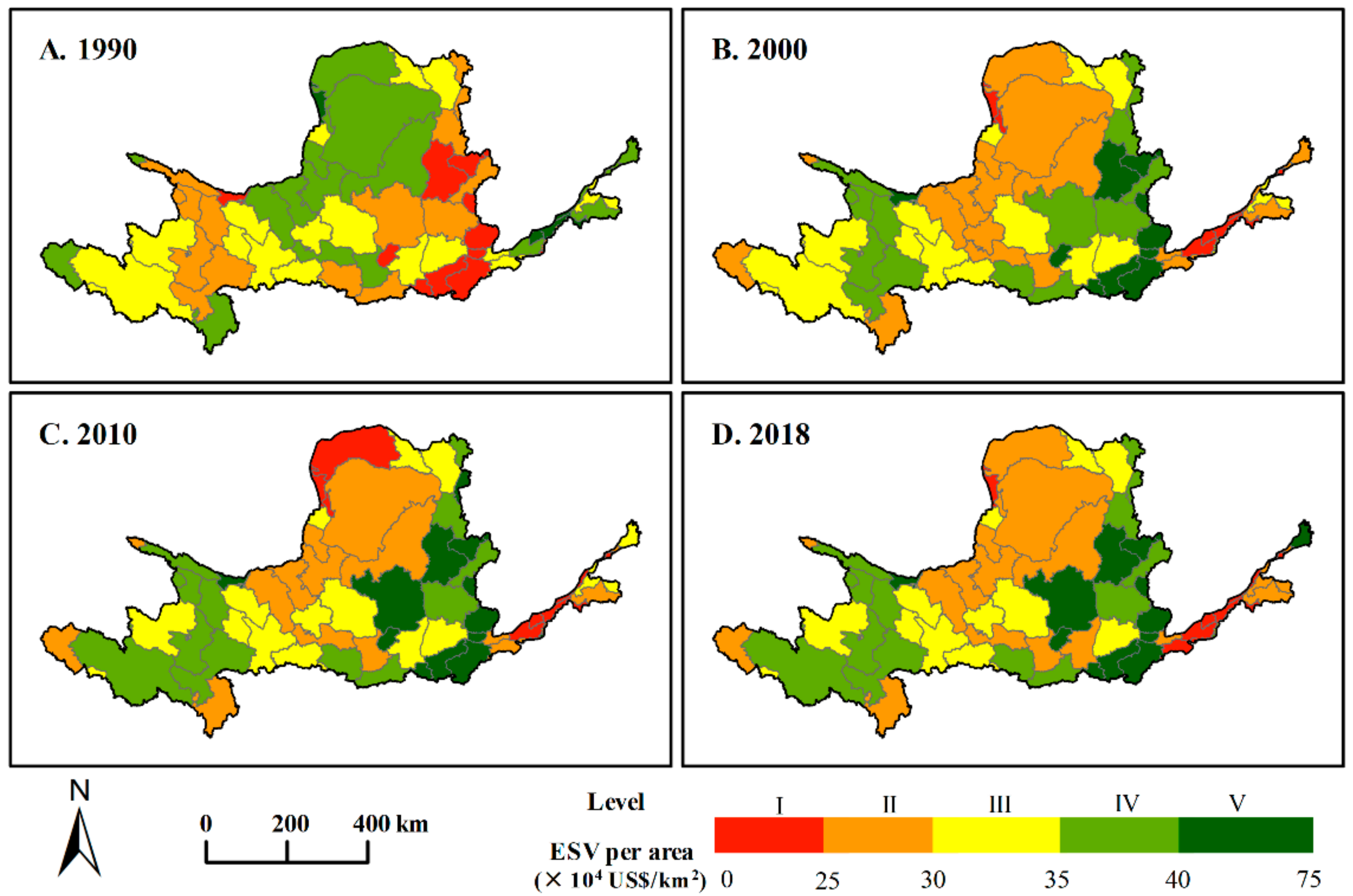
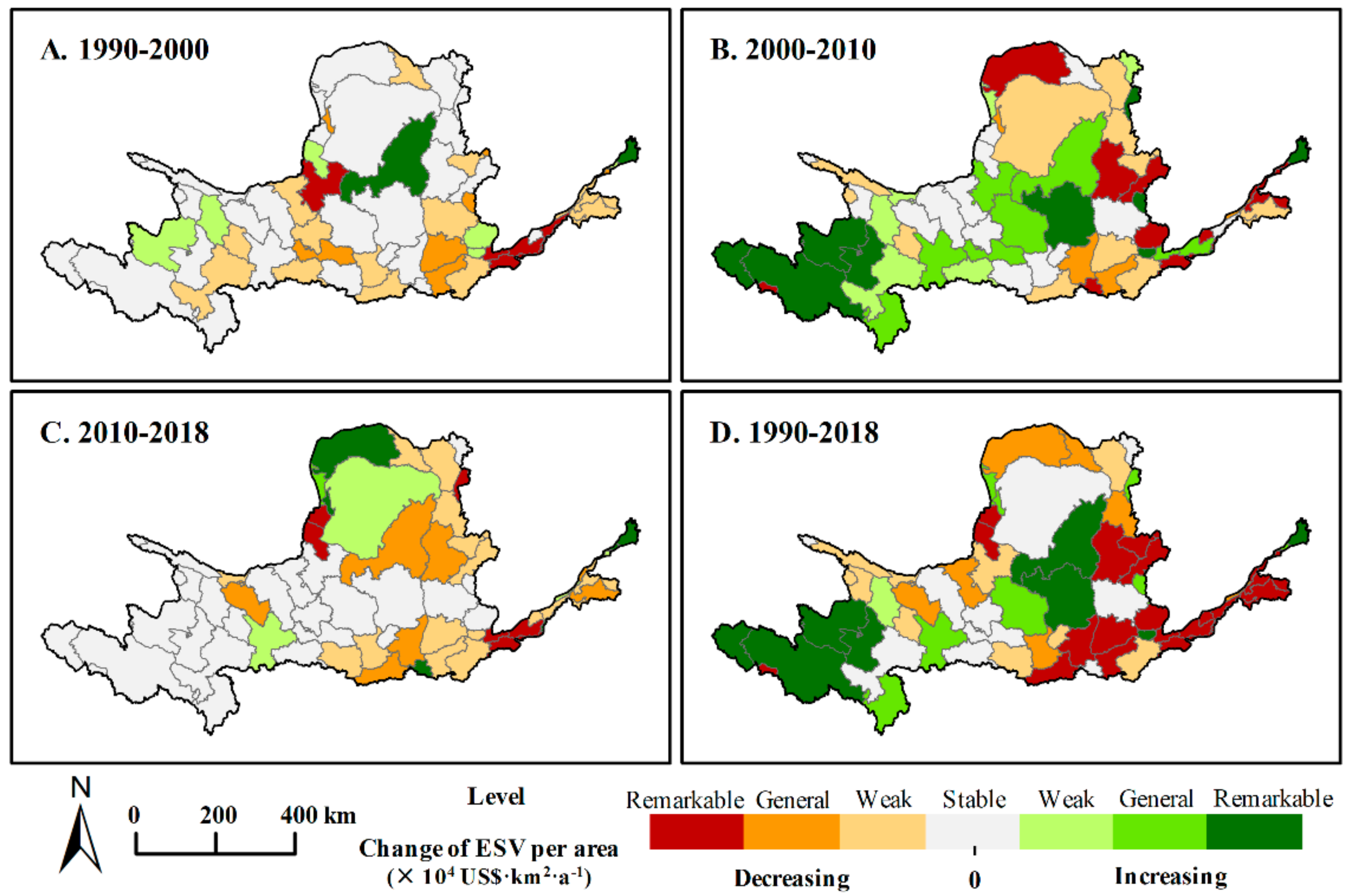
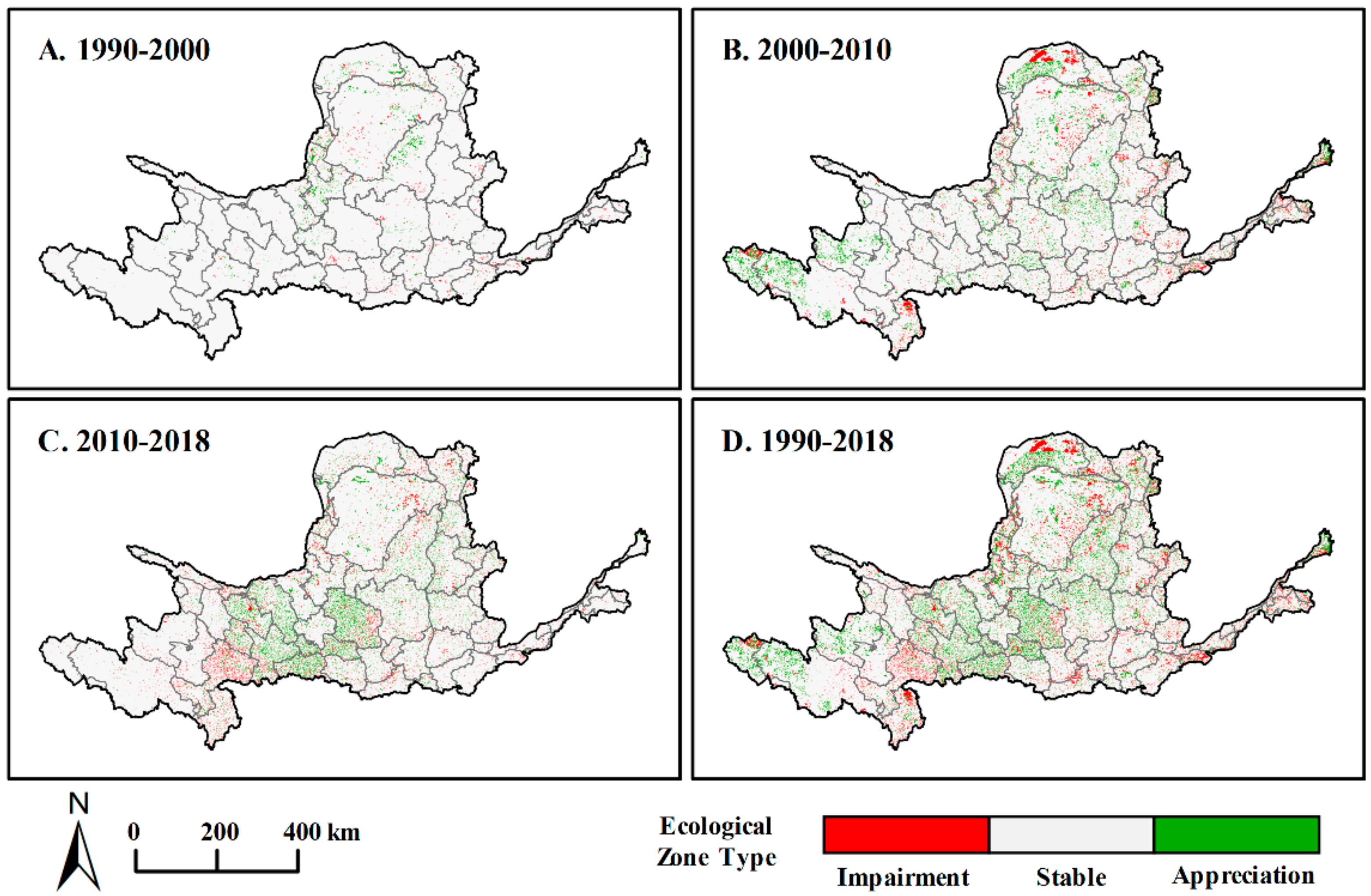
| Primary-Types | Secondary-Types | Cultivated Land | Forestland | Grassland | Water Area | Unused Land |
|---|---|---|---|---|---|---|
| SuyS | Food production | 267.76 | 88.36 | 115.14 | 119.15 | 5.36 |
| Raw material | 104.43 | 797.92 | 96.39 | 78.99 | 10.71 | |
| RegS | Gas regulation | 192.79 | 1156.72 | 401.64 | 390.93 | 16.07 |
| Climate regulation | 259.73 | 1089.78 | 417.71 | 2089.87 | 34.81 | |
| Hydrological regulation | 206.18 | 1095.14 | 407.00 | 4312.27 | 18.74 | |
| Waste treatment | 372.19 | 460.55 | 353.44 | 3915.99 | 69.62 | |
| SutS | Soil formation and retention | 393.61 | 1076.40 | 599.78 | 321.31 | 45.52 |
| Biodiversity protection | 273.12 | 1207.60 | 500.71 | 953.23 | 107.10 | |
| CulS | Recreation and culture | 45.52 | 556.94 | 232.95 | 1222.32 | 64.26 |
| Total | 2115.30 | 7529.41 | 3124.76 | 13,404.07 | 372.19 |
| Cultivated Land | Forestland | Grassland | Water Area | Construction Land | Unused Land | ||
|---|---|---|---|---|---|---|---|
| Area (km2) | 1990 | 217,048 | 103,537 | 383,220 | 14,181 | 17,505 | 73,406 |
| 2000 | 218,884 | 103,436 | 381,622 | 13,654 | 18,994 | 72,307 | |
| 2010 | 212,492 | 106,372 | 384,572 | 14,108 | 25,659 | 65,700 | |
| 2018 | 208,104 | 106,466 | 384,238 | 14,758 | 31,395 | 63,752 | |
| Proportion (%) | 1990 | 26.83 | 12.80 | 47.38 | 1.75 | 2.16 | 9.07 |
| 2000 | 27.06 | 12.79 | 47.18 | 1.69 | 2.35 | 8.94 | |
| 2010 | 26.27 | 13.15 | 47.54 | 1.74 | 3.17 | 8.12 | |
| 2018 | 25.73 | 13.16 | 47.51 | 1.82 | 3.88 | 7.88 | |
| Change percentage (%) | 1990–2000 | 0.85 | −0.10 | −0.42 | −3.72 | 8.51 | −1.50 |
| 2000–2010 | −2.92 | 2.84 | 0.77 | 3.33 | 35.09 | −9.14 | |
| 2010–2018 | −2.07 | 0.09 | −0.09 | 4.61 | 22.35 | −2.96 | |
| 1990–2018 | −4.12 | 2.83 | 0.27 | 4.07 | 79.35 | −13.15 |
| Sequence | 1990–2000 | 2000–2010 | 2010–2018 | ||||||
|---|---|---|---|---|---|---|---|---|---|
| Type | Area (km2) | Change Ratio (%) | Type | Area (km2) | Change Ratio (%) | Type | Area (km2) | Change Ratio (%) | |
| 1 | 31 | 3757.86 | 25.27 | 63 | 12,976.90 | 19.85 | 13 | 14,580.50 | 22.45 |
| 2 | 63 | 2258.58 | 15.19 | 13 | 9184.49 | 14.05 | 31 | 13,310.50 | 20.49 |
| 3 | 36 | 1333.30 | 8.97 | 31 | 8227.12 | 12.59 | 32 | 5538.27 | 8.53 |
| 4 | 15 | 1317.42 | 8.86 | 36 | 7680.71 | 11.75 | 23 | 5345.11 | 8.23 |
| 5 | 13 | 1222.70 | 8.22 | 15 | 6606.34 | 10.11 | 15 | 4733.88 | 7.29 |
| 6 | 23 | 885.09 | 5.95 | 32 | 3143.63 | 4.81 | 63 | 2998.93 | 4.62 |
| 7 | 41 | 861.78 | 5.79 | 12 | 2867.07 | 4.39 | 35 | 2622.12 | 4.04 |
| 8 | 32 | 642.81 | 4.32 | 51 | 2229.56 | 3.41 | 36 | 2207.89 | 3.40 |
| 9 | 61 | 490.99 | 3.30 | 35 | 1754.52 | 2.68 | 12 | 1886.48 | 2.90 |
| 10 | 16 | 365.24 | 2.46 | 23 | 1594.11 | 2.44 | 21 | 1844.11 | 2.84 |
| 11 | 14 | 274.22 | 1.84 | 61 | 1380.05 | 2.11 | 51 | 1714.97 | 2.64 |
| 12 | 12 | 273.10 | 1.84 | 14 | 1073.97 | 1.64 | 14 | 975.63 | 1.50 |
| 13 | 34 | 266.72 | 1.79 | 21 | 1021.60 | 1.56 | 61 | 761.38 | 1.17 |
| 14 | 21 | 171.74 | 1.15 | 41 | 1005.42 | 1.54 | 34 | 754.34 | 1.16 |
| 15 | 43 | 159.54 | 1.07 | 34 | 710.22 | 1.09 | 53 | 691.23 | 1.06 |
| 16 | 35 | 125.18 | 0.84 | 64 | 539.28 | 0.83 | 41 | 662.85 | 1.02 |
| 17 | 46 | 108.95 | 0.73 | 16 | 524.79 | 0.80 | 65 | 590.64 | 0.91 |
| 18 | 62 | 105.12 | 0.71 | 43 | 433.07 | 0.66 | 43 | 565.57 | 0.87 |
| 19 | 64 | 88.25 | 0.59 | 65 | 391.03 | 0.60 | 25 | 482.38 | 0.74 |
| 20 | 26 | 55.91 | 0.38 | 46 | 354.19 | 0.54 | 16 | 480.06 | 0.74 |
| 21 | 42 | 31.37 | 0.21 | 25 | 353.85 | 0.54 | 64 | 450.09 | 0.69 |
| 22 | 25 | 27.60 | 0.19 | 26 | 278.37 | 0.43 | 62 | 368.80 | 0.57 |
| 23 | 65 | 19.35 | 0.13 | 53 | 275.65 | 0.42 | 46 | 327.44 | 0.50 |
| 24 | 24 | 13.36 | 0.09 | 45 | 216.24 | 0.33 | 54 | 279.56 | 0.43 |
| 25 | 45 | 7.86 | 0.05 | 62 | 193.09 | 0.30 | 45 | 233.45 | 0.36 |
| 26 | 51 | 6.03 | 0.04 | 24 | 127.59 | 0.20 | 52 | 142.83 | 0.22 |
| 27 | 53 | 1.57 | 0.01 | 54 | 80.30 | 0.12 | 26 | 138.99 | 0.21 |
| 28 | 52 | 0.17 | 0.00 | 42 | 69.04 | 0.11 | 56 | 96.85 | 0.15 |
| 29 | 54 | 0.22 | 0.00 | 52 | 37.84 | 0.06 | 24 | 89.87 | 0.14 |
| 30 | 56 | 0.13 | 0.00 | 56 | 34.82 | 0.05 | 42 | 71.28 | 0.11 |
| Total | 14,872.17 | 100.00 | 65,364.84 | 100.00 | 64,945.99 | 100.00 | |||
| Region | Land Use Types | Codes | ESV in (108 USD) | ESV Change | ||||||
|---|---|---|---|---|---|---|---|---|---|---|
| 1990 | 2000 | 2010 | 2018 | 1990–2000 | 2000–2010 | 2010–2018 | 1990–2018 | |||
| Yellow River Basin | Cultivated land | 1 | 459.12 | 463.01 | 449.49 | 440.2 | 3.89 | −13.52 | −9.29 | −18.92 |
| Forestland | 2 | 779.57 | 778.81 | 800.92 | 801.63 | −0.76 | 22.11 | 0.71 | 22.06 | |
| Grassland | 3 | 1197.47 | 1192.48 | 1201.69 | 1200.65 | −4.99 | 9.21 | −1.04 | 3.18 | |
| Water area | 4 | 190.08 | 183.02 | 189.1 | 197.82 | −7.06 | 6.08 | 8.72 | 7.74 | |
| Unused land | 6 | 27.32 | 26.91 | 24.45 | 23.73 | −0.41 | −2.46 | −0.72 | −3.59 | |
| Total | 2653.56 | 2644.23 | 2665.65 | 2664.03 | −9.33 | 21.42 | −1.62 | 10.47 | ||
| Upstream | Cultivated land | 1 | 186.65 | 190.13 | 189.7 | 184.94 | 3.48 | −0.43 | −4.76 | −1.71 |
| Forestland | 2 | 325.3 | 323.86 | 335.91 | 338.26 | −1.44 | 12.05 | 2.35 | 12.96 | |
| Grassland | 3 | 950.38 | 943.66 | 952.39 | 953.1 | −6.72 | 8.73 | 0.71 | 2.72 | |
| Water area | 4 | 121.81 | 122.14 | 124.66 | 130.45 | 0.33 | 2.52 | 5.79 | 8.64 | |
| Unused land | 6 | 24.87 | 24.97 | 25.47 | 21.96 | 0.1 | 0.5 | −3.51 | −2.91 | |
| Total | 1609.01 | 1604.76 | 1628.13 | 1628.71 | −4.25 | 23.37 | 0.58 | 19.7 | ||
| Midstream | Cultivated land | 1 | 198.18 | 198.15 | 186.4 | 183.81 | −0.03 | −11.75 | −2.59 | −14.37 |
| Forestland | 2 | 380.94 | 381.97 | 393.42 | 391.85 | 1.03 | 11.45 | −1.57 | 10.91 | |
| Grassland | 3 | 227.82 | 229.92 | 234.71 | 232.95 | 2.1 | 4.79 | −1.76 | 5.13 | |
| Water area | 4 | 33.19 | 32.1 | 29.76 | 30.12 | −1.09 | −2.34 | 0.36 | −3.07 | |
| Unused land | 6 | 2.26 | 1.78 | 1.79 | 1.68 | −0.48 | 0.01 | −0.11 | −0.58 | |
| Total | 842.39 | 843.92 | 846.08 | 840.41 | 1.53 | 2.16 | −5.67 | −1.98 | ||
| Downstream | Cultivated land | 1 | 74.3 | 74.73 | 73.39 | 71.45 | 0.43 | −1.34 | −1.94 | −2.85 |
| Forestland | 2 | 73.34 | 72.98 | 71.59 | 71.52 | −0.36 | −1.39 | −0.07 | −1.82 | |
| Grassland | 3 | 19.23 | 18.84 | 14.59 | 14.59 | −0.39 | −4.25 | 0 | −4.64 | |
| Water area | 4 | 34.94 | 28.64 | 34.15 | 36.77 | −6.3 | 5.51 | 2.62 | 1.83 | |
| Unused land | 6 | 0.18 | 0.15 | 0.05 | 0.09 | −0.03 | −0.1 | 0.04 | −0.09 | |
| Total | 201.99 | 195.34 | 193.77 | 194.42 | −6.65 | −1.57 | 0.65 | −7.57 | ||
| Type | 1990–2000 | 2000–2010 | 2010–2018 | 1990–2018 | ||||
|---|---|---|---|---|---|---|---|---|
| Changes of ESV (×108 USD) | Contribution Rate (%) | Changes of ESV (×108 USD) | Contribution Rate (%) | Changes of ESV (×108 USD) | Contribution Rate (%) | Changes of ESV (×108 USD) | Contribution Rate (%) | |
| 12 | 1.479 | 2.943 | 15.523 | 7.639 | 10.213 | 5.227 | 22.947 | 6.374 |
| 13 | 1.234 | 2.455 | 9.271 | 4.563 | 14.718 | 7.532 | 20.550 | 5.708 |
| 14 | 3.096 | 6.160 | 12.124 | 5.967 | 11.014 | 5.637 | 17.042 | 4.734 |
| 15 | −2.787 | −5.546 | −13.974 | −6.877 | −10.014 | −5.125 | −23.900 | −6.639 |
| 16 | −0.637 | −1.267 | −0.915 | −0.450 | −0.837 | −0.428 | −1.287 | −0.358 |
| 21 | −0.930 | −1.851 | −5.531 | −2.722 | −9.984 | −5.110 | −12.370 | −3.436 |
| 23 | −3.899 | −7.758 | −7.021 | −3.455 | −23.543 | −12.049 | −29.065 | −8.074 |
| 24 | 0.078 | 0.156 | 0.750 | 0.369 | 0.528 | 0.270 | 1.356 | 0.377 |
| 25 | −0.208 | −0.414 | −2.664 | −1.311 | −3.632 | −1.859 | −5.336 | −1.482 |
| 26 | −0.400 | −0.796 | −1.992 | −0.980 | −0.995 | −0.509 | −2.632 | −0.731 |
| 31 | −3.793 | −7.547 | −8.305 | −4.087 | −13.436 | −6.876 | −20.564 | −5.712 |
| 32 | 2.831 | 5.633 | 13.847 | 6.815 | 24.394 | 12.484 | 35.481 | 9.856 |
| 34 | 2.742 | 5.456 | 7.301 | 3.593 | 7.754 | 3.968 | 14.866 | 4.130 |
| 35 | −0.391 | −0.778 | −5.482 | −2.698 | −8.193 | −4.193 | −12.519 | −3.478 |
| 36 | −3.670 | −7.303 | −21.142 | −10.405 | −6.077 | −3.110 | −26.487 | −7.358 |
| 41 | −9.728 | −19.357 | −11.350 | −5.586 | −7.483 | −3.830 | −19.829 | −5.508 |
| 42 | −0.184 | −0.366 | −0.406 | −0.200 | −0.419 | −0.214 | −0.661 | −0.184 |
| 43 | −1.640 | −3.263 | −4.452 | −2.191 | −5.814 | −2.975 | −8.331 | −2.314 |
| 45 | −0.105 | −0.209 | −2.898 | −1.426 | −3.129 | −1.601 | −4.994 | −1.387 |
| 46 | −1.420 | −2.826 | −4.616 | −2.272 | −4.267 | −2.184 | −5.824 | −1.618 |
| 51 | 0.013 | 0.026 | 4.716 | 2.321 | 3.628 | 1.857 | 5.670 | 1.575 |
| 52 | 0.001 | 0.002 | 0.285 | 0.140 | 1.075 | 0.550 | 0.585 | 0.163 |
| 53 | 0.005 | 0.010 | 0.861 | 0.424 | 2.160 | 1.105 | 1.603 | 0.445 |
| 54 | 0.003 | 0.006 | 1.076 | 0.530 | 3.747 | 1.918 | 2.141 | 0.595 |
| 56 | 0.000 | 0.000 | 0.013 | 0.006 | 0.036 | 0.018 | 0.018 | 0.005 |
| 61 | 0.856 | 1.703 | 2.406 | 1.184 | 1.327 | 0.679 | 3.713 | 1.031 |
| 62 | 0.752 | 1.496 | 1.382 | 0.680 | 2.640 | 1.351 | 4.286 | 1.191 |
| 63 | 6.217 | 12.371 | 35.720 | 17.579 | 8.255 | 4.225 | 44.918 | 12.477 |
| 64 | 1.150 | 2.288 | 7.028 | 3.459 | 5.866 | 3.002 | 10.653 | 2.959 |
| 65 | −0.007 | −0.014 | −0.146 | −0.072 | −0.220 | −0.113 | −0.366 | −0.102 |
Publisher’s Note: MDPI stays neutral with regard to jurisdictional claims in published maps and institutional affiliations. |
© 2020 by the authors. Licensee MDPI, Basel, Switzerland. This article is an open access article distributed under the terms and conditions of the Creative Commons Attribution (CC BY) license (http://creativecommons.org/licenses/by/4.0/).
Share and Cite
Yin, D.; Li, X.; Li, G.; Zhang, J.; Yu, H. Spatio-Temporal Evolution of Land Use Transition and Its Eco-Environmental Effects: A Case Study of the Yellow River Basin, China. Land 2020, 9, 514. https://doi.org/10.3390/land9120514
Yin D, Li X, Li G, Zhang J, Yu H. Spatio-Temporal Evolution of Land Use Transition and Its Eco-Environmental Effects: A Case Study of the Yellow River Basin, China. Land. 2020; 9(12):514. https://doi.org/10.3390/land9120514
Chicago/Turabian StyleYin, Dengyu, Xiaoshun Li, Guie Li, Jian Zhang, and Haochen Yu. 2020. "Spatio-Temporal Evolution of Land Use Transition and Its Eco-Environmental Effects: A Case Study of the Yellow River Basin, China" Land 9, no. 12: 514. https://doi.org/10.3390/land9120514
APA StyleYin, D., Li, X., Li, G., Zhang, J., & Yu, H. (2020). Spatio-Temporal Evolution of Land Use Transition and Its Eco-Environmental Effects: A Case Study of the Yellow River Basin, China. Land, 9(12), 514. https://doi.org/10.3390/land9120514








